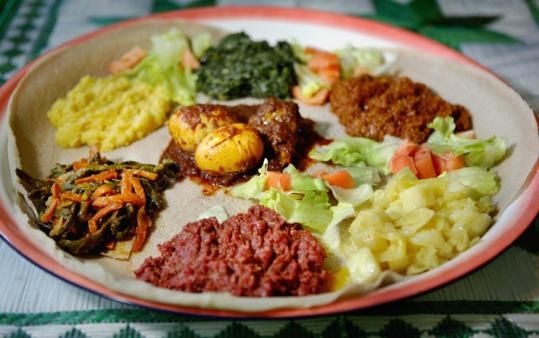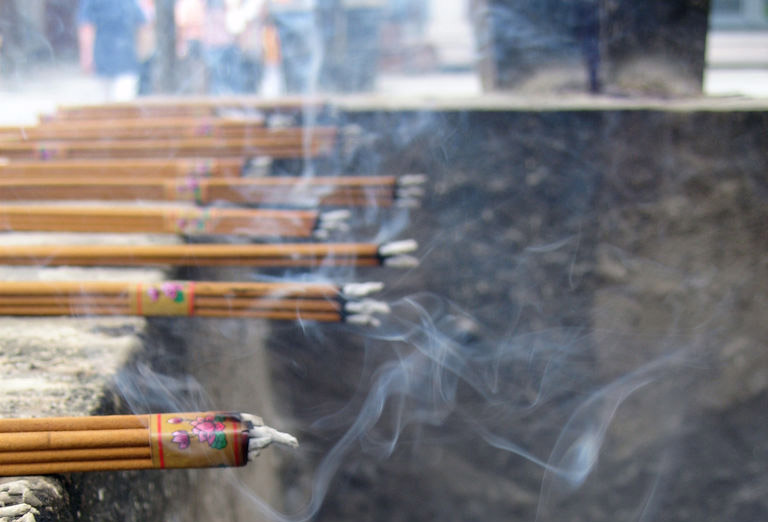|
Coffee Ceremony
The Habesha coffee ceremony is a core cultural custom in Ethiopia and Eritrea. There is a routine of serving coffee daily, mainly for the purpose of getting together with relatives, neighbors, or other visitors. If coffee is politely declined, then tea will most likely be served. Loose grass is spread on the floor where the coffee ceremony is held, often decorated with small yellow flowers. Composite flowers are sometimes used, especially around the celebration of Meskel (an Orthodox holiday celebrated by Eritreans and Ethiopians). Brewing The ceremony is typically performed by the woman of the household and is considered an honor. The coffee is brewed by first roasting the green coffee beans over an open flame in a pan. This is followed by the grinding of the beans using Mukecha, a traditional wooden mortar and pestle . The finely ground beans are then brewed in a jebena - a traditional clay pot, which contains boiling water and will be left on an open flame for a couple o ... [...More Info...] [...Related Items...] OR: [Wikipedia] [Google] [Baidu] |
Tigrinya Language
Tigrinya, sometimes romanized as Tigrigna, is an Ethio-Semitic languages, Ethio-Semitic language, which is a subgrouping within the Semitic languages, Semitic branch of the Afroasiatic languages. It is primarily spoken by the Tigrinya people, Tigrinya and Tigrayans, Tigrayan peoples native to Eritrea and the Ethiopian state of the Tigray Region, respectively. It is also spoken by the global diaspora of these regions. History and literature Although it differs markedly from the Geʽez (Classical Ethiopic) language, for instance in having phrasal verbs, and in using a word order that places the main verb last instead of first in the sentence, there is a strong influence of Geʽez on Tigrinya literature, especially with terms relating to Christian life, Biblical names, and so on. Ge'ez, because of its status in Eritrean and Ethiopian culture, and possibly also its simple structure, acted as a literary medium until relatively recent times. The earliest written example of Tigriny ... [...More Info...] [...Related Items...] OR: [Wikipedia] [Google] [Baidu] |
Culture Of Eritrea
The culture of Eritrea is the collective cultural heritage of the various populations native to Eritrea. Eritrea has nine recognized ethnic groups. Each group have their own unique traditions and customs but some traditions are shared and appreciated among different ethnic groups. The local culture consists of various, and often quite similar, traditions practiced by the nation's many Cushitic languages, Cushitic and Ethiopian Semitic languages, Ethiopian Semitic-speaking Afroasiatic languages, Afro-Asiatic ethnic groups, in addition to those practiced by the area's Nilotic minorities. Eritrean culture is in some ways similar to the cultures of other countries in the region. Coffee ceremony One of the most recognizable parts of Eritrean culture is the coffee ceremony. Coffee (Ge'ez alphabet, Ge'ez ቡን ''būn'') is offered when visiting friends, during festivities, or as a daily staple of life. If coffee is politely declined then most likely tea ("shy" ሻሂ ) will be served ... [...More Info...] [...Related Items...] OR: [Wikipedia] [Google] [Baidu] |
Cuisine Of Ethiopia
Ethiopian cuisine ( "Ye-Ītyōṗṗyā məgəb") characteristically consists of vegetable and often very spicy meat dishes. This is usually in the form of ''wat,'' a thick stew, served on top of '' injera'' (), a large sourdough flatbread,Javins, Marie."Eating and Drinking in Ethiopia." Accessed July 2011. which is about in diameter and made out of fermented flour. usually eat with their right hands, using pieces of to pick up bites of entrées and side dishes. The [...More Info...] [...Related Items...] OR: [Wikipedia] [Google] [Baidu] |
Cuisine Of Eritrea
Eritrean cuisine is based on Eritrea's native culinary traditions, but also arises from social interchanges with other regions. The local cuisine shares very strong similarities with the cuisine of neighboring Ethiopia with several dishes being cultural to both nations as a result of the two nations having been unified for hundreds of years. It also has influences from Italian cuisine due to the Italian colonization of the nation, and minor influences from other cuisines in the region. Overview Eritrean cuisine shares similarities with surrounding countries' cuisines; however, the cuisine has its unique characteristics. The main traditional food in Eritrean cuisine is '' tsebhi'' (stew), served with '' injera'' (flatbread made from teff, wheat, or sorghum and ''hilbet'' (paste made from legumes; mainly lentil and faba beans). A typical traditional Eritrean dish consists of ''injera'' accompanied by a spicy stew, which frequently includes beef, goat, lamb or fish. Overall, ... [...More Info...] [...Related Items...] OR: [Wikipedia] [Google] [Baidu] |
Tea Ceremony
Tea ceremony is a ritualized practice of making and serving tea (茶 ''cha'') in East Asia practiced in the Sinosphere. The original term from China (), literally translated as either "''way of tea''", "''etiquette for tea or tea rite''",Heiss, Mary Lou and Heiss, Robert J. "The Story of Tea: A Cultural History and Drinking Guide". Berkeley: Ten Speed Press, 2007 p.197-8 or "''art of tea''" among the languages in the Sinosphere, is a cultural activity involving the ceremonial preparation and presentation of tea. Korean, Vietnamese and Japanese tea culture were inspired by the Chinese tea culture during ancient and medieval times, particularly after the successful transplant of the tea plant from Tang China to Korea, Vietnam and Japan by traveling Buddhist monks and scholars in 8th century and onwards. One can also refer to the whole set of rituals, tools, gestures, etc. used in such ceremonies as tea culture. All of these tea ceremonies and rituals contain "an adoration of the b ... [...More Info...] [...Related Items...] OR: [Wikipedia] [Google] [Baidu] |
Himbasha
Himbasha () or Ambasha (), is an Ethiopian and Eritrean celebration bread that is slightly sweet. It became popular in Eritrean cuisine, often served at special occasions. It is prepared in a number of varieties depending on region and nationality with the main two being the quintessential Ethiopian variant, and the more distinctive Eritrean flavoring with raisins. The dough is given a decorative touch before baking. The design varies in detail, but in general, is given the shape of a wheel with indentations to create several spokes (see picture). Common additions to the recipe include candied orange, ginger, or ground cardamom seeds, although plain varieties are not unheard of. See also * Ethiopian cuisine * List of African dishes Africa is the second-largest continent on Earth, and is home to hundreds of different cultural and ethnic groups. This diversity is reflected in the many local culinary traditions in choice of ingredients, style of preparation, and cooking techn ... [...More Info...] [...Related Items...] OR: [Wikipedia] [Google] [Baidu] |
Peanut
The peanut (''Arachis hypogaea''), also known as the groundnut, goober (US), goober pea, pindar (US) or monkey nut (UK), is a legume crop grown mainly for its edible seeds. It is widely grown in the tropics and subtropics by small and large commercial producers, both as a grain legume and as an oil crop. Atypically among legumes, peanut pods geocarpy, develop underground; this led botanist Carl Linnaeus to name peanuts ''hypogaea'', which means "under the earth". The peanut belongs to the botanical family Fabaceae (or Leguminosae), commonly known as the legume, bean, or pea family. Like most other legumes, peanuts harbor symbiotic nitrogen-fixing bacteria in root nodules, which improve soil fertility, making them valuable in crop rotations. Despite not meeting the Botanical nut, botanical definition of a nut as "a fruit whose ovary (botany), ovary wall becomes hard at maturity," peanuts are usually categorized as nuts for culinary purposes and in common English. Some pe ... [...More Info...] [...Related Items...] OR: [Wikipedia] [Google] [Baidu] |
Popcorn
Popcorn (also called popped corn, popcorns, or pop-corn) is a variety of corn kernel which expands and puffs up when heated. The term also refers to the snack food produced by the expansion. It is one of the oldest snacks, with evidence of popcorn dating back thousands of years in the Americas. It is commonly eaten salted, buttered, sweetened, or with artificial flavorings. A popcorn kernel's strong hull contains the seed's hard, starchy shell endosperm with 14–20% moisture, which turns to steam as the kernel is heated. Pressure from the steam continues to build until the hull ruptures, allowing the kernel to forcefully expand, to 20 to 50 times its original size, and then cool. Some strains of corn ( taxonomized as ''Zea mays'') are cultivated specifically as popping corns. The ''Zea mays'' variety ''everta'', a special kind of flint corn, is the most common of these. Popcorn is one of six major types of corn, which includes dent corn, flint corn, pod corn, flour c ... [...More Info...] [...Related Items...] OR: [Wikipedia] [Google] [Baidu] |
Niter Kibbeh
''Niter kibbeh'', or ''niter qibe'' ( '), also called (in Tigrinya), is a seasoned, clarified butter used in Ethiopian and Eritrean cuisine. Its preparation is similar to that of ghee, but ''niter kibbeh'' is simmered with spices such as ''besobela'' (known as Ethiopian sacred basil), koseret, fenugreek, cumin, coriander, turmeric, Ethiopian cardamom (korarima), cinnamon, or nutmeg before straining, imparting a distinct, spicy aroma. The version using vegetable oil instead of butter is called ''yeqimem zeyet''. See also * List of Ethiopian dishes and foods * Kibbeh Kibbeh (, also kubba and other spellings; ; ) is a popular dish in the Arab world and the Levant in particular based on spiced lean ground meat and bulgur wheat. Kibbeh is considered to be a national dish of Lebanon and Syria. In Levantine ... References External links ''Niter kibbeh'' recipeAuthentic ''Niter Kibbeh'' (Ethiopian Spiced Clarified Butter) recipe Butter Tesmi Ethiopian c ... [...More Info...] [...Related Items...] OR: [Wikipedia] [Google] [Baidu] |
Salt
In common usage, salt is a mineral composed primarily of sodium chloride (NaCl). When used in food, especially in granulated form, it is more formally called table salt. In the form of a natural crystalline mineral, salt is also known as rock salt or halite. Salt is essential for life in general (being the source of the essential dietary minerals sodium and chlorine), and saltiness is one of the basic human tastes. Salt is one of the oldest and most ubiquitous food seasonings, and is known to uniformly improve the taste perception of food. Salting, brining, and pickling are ancient and important methods of food preservation. Some of the earliest evidence of salt processing dates to around 6000 BC, when people living in the area of present-day Romania boiled spring water to extract salts; a salt works in China dates to approximately the same period. Salt was prized by the ancient Hebrews, Greeks, Romans, Byzantines, Hittites, Egyptians, and Indians. Salt became a ... [...More Info...] [...Related Items...] OR: [Wikipedia] [Google] [Baidu] |
Incense
Incense is an aromatic biotic material that releases fragrant smoke when burnt. The term is used for either the material or the aroma. Incense is used for aesthetic reasons, religious worship, aromatherapy, meditation, and ceremonial reasons. It may also be used as a simple deodorant or insect repellent. Incense is composed of aromatic plant materials, often combined with essential oils. The forms taken by incense differ with the underlying culture, and have changed with advances in technology and increasing number of uses. Incense can generally be separated into two main types: "indirect-burning" and "direct-burning." Indirect-burning incense (or "non-combustible incense") is not capable of burning on its own, and requires a separate heat source. Direct-burning incense (or "combustible incense") is lit directly by a flame and then fanned or blown out, leaving a glowing ember that smoulders and releases a smoky fragrance. Direct-burning incense is either a paste formed around a ... [...More Info...] [...Related Items...] OR: [Wikipedia] [Google] [Baidu] |






